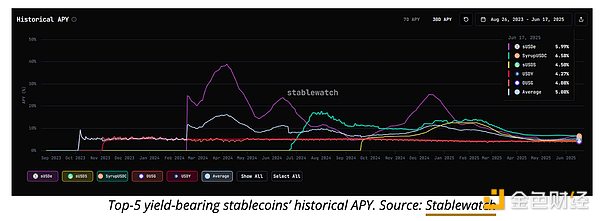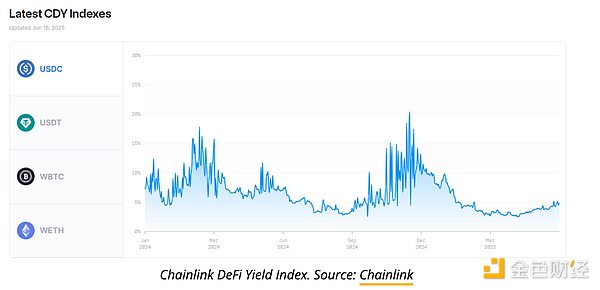Ethereum may not have lost this battle for yield; it has simply won in a different way.
Written by: Marie Poteriaieva
Translated by: Shaw, Golden Finance
Fixed income is no longer the exclusive domain of traditional finance. On-chain yield has become a core pillar of cryptocurrency. As the largest PoS blockchain, Ethereum occupies a central position, with its economy relying on users locking up their ETH to help secure the network and earn yield.
However, Ethereum is not the only option. Today, cryptocurrency users have access to an increasing variety of yield-generating products, some of which directly compete with Ethereum's staking yields, potentially undermining Ethereum's blockchain. Yield-bearing stablecoins offer greater flexibility and easier access to traditional finance, with yields linked to U.S. Treasury bonds and synthetic strategies.
Meanwhile, DeFi lending protocols have expanded the range of assets and risk profiles available to depositors. Both often provide higher yields than Ethereum staking, raising a key question: Is Ethereum quietly losing this battle for yield?
Declining Ethereum Staking Yields
Ethereum staking yields are the rewards validators earn for maintaining network security. They come from two sources: consensus layer rewards and execution layer rewards.
Consensus rewards are issued by the protocol and depend on the total amount of staked ETH. By design, the more ETH staked in the network, the lower the rewards for each validator. This formula follows an inverse square root curve, ensuring that as more funds enter the system, yields gradually decrease. Execution layer rewards include priority fees (the fees users pay to have their transactions included in a block) and maximum extractable value (MEV), which is the additional profit gained by optimizing transaction order. These extra rewards fluctuate based on network usage and validator strategies.
Since the Merge in September 2022, Ethereum's staking yield has gradually declined. The total yield (including consensus rewards and tips) has dropped from a peak of around 5.3% to below 3%, reflecting the growth in total staked ETH and the network's increasing maturity. In fact, the current staked ETH exceeds 35 million, accounting for 28% of its total supply.

However, only independent validators (those running their own nodes and locking 32 ETH) can earn the full staking yield. While they can receive 100% of the rewards, they also bear the responsibility of staying online, maintaining hardware, and avoiding penalties. Most users opt for more convenient solutions, such as liquid staking protocols like Lido or custodial services offered by exchanges. These platforms simplify access but charge fees (typically between 10% and 25%), further reducing users' final yields.
While Ethereum's annual staking yield below 3% may seem low, it still holds an advantage compared to its competitor Solana. Solana's current average network annual yield is about 2.5% (with a maximum annual yield of 7%). In terms of actual yield, Ethereum's yield is even higher: its net inflation rate is only 0.7%, while Solana's net inflation rate is 4.5%, meaning that stakers on Ethereum experience less dilution over time. However, Ethereum's main challenge does not come from other blockchains but from the rise of alternative protocols that can offer yield.
Yield-Bearing Stablecoins Gaining Market Share
Yield-bearing stablecoins allow users to hold assets pegged to the U.S. dollar while earning passive income, typically derived from U.S. Treasury bonds or synthetic strategies. Unlike traditional stablecoins like USDC or USDT, which do not pay yields to users, these new stablecoin protocols distribute a portion of the underlying yield to users.
The five major yield stablecoins—sUSDe, sUSDS, SyrupUSDC, USDY, and OUSG—account for over 70% of the $11.4 billion market and employ different methods to generate yield.
sUSDe, issued by Ethena, a company invested in by BlackRock, uses a synthetic delta-neutral strategy involving ETH derivatives and staking rewards. Its yield ranks among the highest in the cryptocurrency space, with historical annual yields between 10% and 25%. Although the current yield has dropped to around 6%, sUSDe still leads most competitors, but its complex, market-dependent strategy carries higher risks.
sUSDS, developed by Reflexer and Sky (formerly MakerDAO), is backed by sDAI and RWA. Its yield is more conservative, currently at 4.5%, focusing on decentralization and risk aversion.
SyrupUSDC, issued by Maple Finance, achieves yield through tokenized Treasury bonds and MEV strategies. Its yield reached double digits at launch and is currently at 6.5%, still higher than most centralized alternatives.
USDY, issued by Ondo Finance, tokenizes short-term Treasury bonds, with a yield of 4.3%, targeting regulated and lower-risk institutions. Similarly, OUSG from Ondo is backed by BlackRock's short-term Treasury ETF, with a yield of about 4%, and complies with full KYC requirements, placing a strong emphasis on compliance.

The main differences between these products lie in their collateral, risk profiles, and accessibility. sUSDe, SyrupUSDC, and sUSDS are fully DeFi-native and permissionless, while USDY and OUSG require KYC and cater to institutional users.
Yield-bearing stablecoins are rapidly gaining favor, perfectly combining the stability of the dollar with yield opportunities that were once exclusive to institutional investors. Over the past year, this sector has grown by 235%, and with the increasing demand for on-chain fixed income, there are no signs of slowing down.
DeFi Lending Still Centered on Ethereum
Decentralized lending platforms like Aave, Compound, and Morpho allow users to earn yield by providing crypto assets to lending pools. These protocols set interest rates algorithmically based on supply and demand. When borrowing demand rises, interest rates also increase, making DeFi lending yields more dynamic and often uncorrelated with traditional markets.
The Chainlink DeFi Yield Index shows that borrowing rates for stablecoins typically hover around 5% for USDC and about 3.8% for USDT. During bull markets or speculative frenzies (e.g., from February to March and November to December 2024), borrowing demand surges, and yields often skyrocket. Unlike banks that adjust rates based on central bank policies and credit risk, DeFi lending is market-driven. This creates opportunities for higher returns but also exposes borrowers to unique risks, such as smart contract vulnerabilities, oracle failures, price manipulation, and liquidity crunches.

Ironically, many of these products are built on Ethereum itself. Yield-bearing stablecoins, tokenized Treasury bonds, and DeFi lending protocols largely rely on Ethereum's infrastructure, and in some cases, even incorporate ETH directly into their yield strategies.
Ethereum remains the most trusted blockchain in both traditional finance and crypto-native finance, continuing to lead in custodial DeFi and risk assets (RWA). As these areas gain popularity, they drive increased network usage, rising transaction fees, and indirectly enhance the long-term value of ETH. In this sense, Ethereum may not have lost this battle for yield—it has simply won in a different way.
免责声明:本文章仅代表作者个人观点,不代表本平台的立场和观点。本文章仅供信息分享,不构成对任何人的任何投资建议。用户与作者之间的任何争议,与本平台无关。如网页中刊载的文章或图片涉及侵权,请提供相关的权利证明和身份证明发送邮件到support@aicoin.com,本平台相关工作人员将会进行核查。




